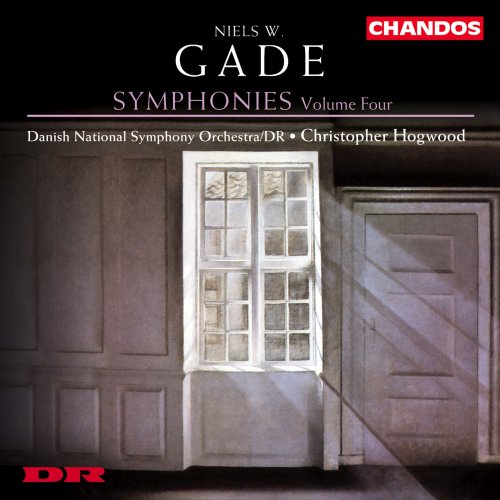
Christopher Hogwood - Niels Gade: Symphonies, Vol. 4 (2003)
BAND/ARTIST: Christopher Hogwood
- Title: Niels Gade: Symphonies, Vol. 4
- Year Of Release: 2003
- Label: Chandos
- Genre: Classical
- Quality: FLAC (tracks)
- Total Time: 58:07
- Total Size: 285 Mb
- WebSite: Album Preview
Tracklist:
Symphony No. 1 in C Minor, Op. 5, "Paa Sjolunds fagre sletter" (Niels Gade)
1. I. Moderato con moto - Allegro energico - Con più moto. 09:35
2. II. Scherzo. Allegro risoluto quasi presto - Meno allegro - Tempo I - Meno allegro - Tempo I - Meno allegro - Presto. 05:40
3. III. Andantino grazioso. 08:47
4. IV. Finale. Molto allegro ma con fuoco - Molto marcato. 07:08
Symphony No. 5 in D minor, Op. 25 (Niels Gade)
5. I. Allegro con fuoco. 08:43
6. II. Andante sostenuto. 06:28
7. III. Scherzo. Allegro molto vivace. 04:08
8. IV. Finale. Andante con moto - Allegro vivace. 07:38
Performers:
Danish National Symphony Orchestra
Conductor - Christopher Hogwood
Symphony No. 1 in C Minor, Op. 5, "Paa Sjolunds fagre sletter" (Niels Gade)
1. I. Moderato con moto - Allegro energico - Con più moto. 09:35
2. II. Scherzo. Allegro risoluto quasi presto - Meno allegro - Tempo I - Meno allegro - Tempo I - Meno allegro - Presto. 05:40
3. III. Andantino grazioso. 08:47
4. IV. Finale. Molto allegro ma con fuoco - Molto marcato. 07:08
Symphony No. 5 in D minor, Op. 25 (Niels Gade)
5. I. Allegro con fuoco. 08:43
6. II. Andante sostenuto. 06:28
7. III. Scherzo. Allegro molto vivace. 04:08
8. IV. Finale. Andante con moto - Allegro vivace. 07:38
Performers:
Danish National Symphony Orchestra
Conductor - Christopher Hogwood
If not the most adventurous of composers, and in his later years overly conservative, Gade in his youth certainly had his moments. Echoes of Ossian (1840) is an impressive Op 1 by any standard, a well-organised sonata-allegro in a single, purposeful tempo. Hogwood underlines its expressive and dramatic contrasts very nicely indeed and, in Chandos’s rich sound, this must count as a first choice.
Gade’s inventiveness is evident in all four symphonies presented here, albeit in very different ways. The Sixth (1856-57) is perhaps the most perfect, Classical in design although with a minatory feel suggestive at times of middle-period Haydn. If it stays within its own clearly defined harmonic and stylistic limits, the First, Third and Fifth do not. No 1 (1842), based on an old ballad and incorporating his own earlier setting of it, is bright and full of life: no wonder Mendelssohn and the Leipzig audience were enchanted. The Third (1846-47) is a different proposition, more Romantic in tone, its first movement too much so causing the composer to replace it with a less radical opening span (the Presto tempo marking of which must still have raised a few eyebrows). The original Andante – Allegro energico is included here in its first recording, proving a fine if turbulent sonata Allegro. The Fifth (1852) has a Mendelssohnian poise and grace plus one startling – if ultimately still-born – innovation: the piano as an orchestral instrument (over half a century before Stravinsky’s Petrushka or Shostakovich’s First Symphony). The Fifth is very definitely not a concerto, but a true symphony with an extended keyboard part, sometimes as soloist, sometimes as colouristic device.
The performances are all very nicely drawn, the First and Fifth particularly so (Brautigam being just about ideal). As before, Hogwood’s accounts have more energy than Schønwandt’s on Dacapo, and much livelier sound; honours may be more even with Järvi’s cycle, but overall I think Hogwood now has the edge; Kitaenko’s version of No 1 and Ossian remain unsurpassed.
Gade’s inventiveness is evident in all four symphonies presented here, albeit in very different ways. The Sixth (1856-57) is perhaps the most perfect, Classical in design although with a minatory feel suggestive at times of middle-period Haydn. If it stays within its own clearly defined harmonic and stylistic limits, the First, Third and Fifth do not. No 1 (1842), based on an old ballad and incorporating his own earlier setting of it, is bright and full of life: no wonder Mendelssohn and the Leipzig audience were enchanted. The Third (1846-47) is a different proposition, more Romantic in tone, its first movement too much so causing the composer to replace it with a less radical opening span (the Presto tempo marking of which must still have raised a few eyebrows). The original Andante – Allegro energico is included here in its first recording, proving a fine if turbulent sonata Allegro. The Fifth (1852) has a Mendelssohnian poise and grace plus one startling – if ultimately still-born – innovation: the piano as an orchestral instrument (over half a century before Stravinsky’s Petrushka or Shostakovich’s First Symphony). The Fifth is very definitely not a concerto, but a true symphony with an extended keyboard part, sometimes as soloist, sometimes as colouristic device.
The performances are all very nicely drawn, the First and Fifth particularly so (Brautigam being just about ideal). As before, Hogwood’s accounts have more energy than Schønwandt’s on Dacapo, and much livelier sound; honours may be more even with Järvi’s cycle, but overall I think Hogwood now has the edge; Kitaenko’s version of No 1 and Ossian remain unsurpassed.
As a ISRA.CLOUD's PREMIUM member you will have the following benefits:
- Unlimited high speed downloads
- Download directly without waiting time
- Unlimited parallel downloads
- Support for download accelerators
- No advertising
- Resume broken downloads


